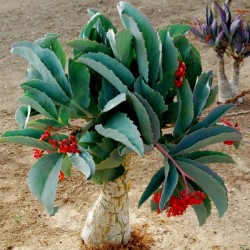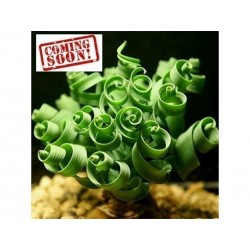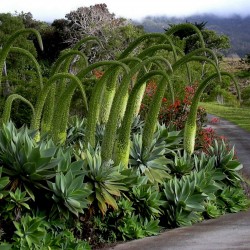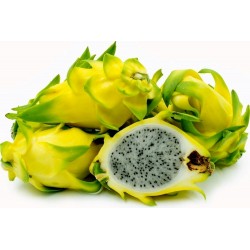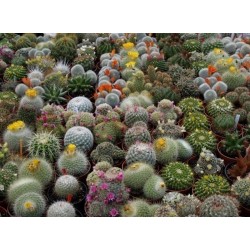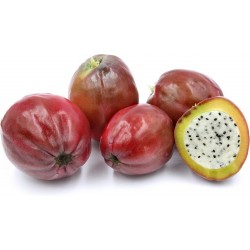
Roślina odporna na zimno i mróz

Opuncja figowa nasion...
Cena podstawowa
2,25 €
-15%
Cena
1,91 €
(SKU: CT 1)
Seeds Gallery EU,
5/
5
<!DOCTYPE html>
<html>
<head>
<meta http-equiv="Content-Type" content="text/html; charset=UTF-8" />
</head>
<body>
<h2><strong>Opuncja figowa nasion (Opuntia Ficus-Indica)</strong></h2>
<h2><span style="color: #ff0000;"><strong>Cena za opakowanie 25 + - (0,5g) nasion.</strong></span></h2>
<p><b>Opuncja figowa</b><span> </span>(<i>Opuntia ficus-indica</i>) – gatunek<span> </span>opuncji<span> </span>pochodzący z<span> </span>Meksyku, lecz uprawiany również w wielu innych krajach o ciepłym klimacie, także w południowej<span> </span>Europie<sup id="cite_ref-grin_2-0" class="reference">[2]</sup>. Łatwo przystosowuje się do różnych warunków glebowych. Aztekowie uważali ją za roślinę świętą i wykorzystywali do różnych celów. Pierwsze owoce, dotarły do Europy prawdopodobnie już pod koniec XV w. po powrocie wyprawy<span> </span>Krzysztofa Kolumba. Stąd używana do tej pory nazwa<span> </span><i>ficus indica</i><span> </span>(figa indyjska).</p>
<h2><span class="mw-headline" id="Nazewnictwo">Nazewnictwo</span></h2>
<p>Gatunek o licznych<span> </span>synonimach<span> </span>nazwy naukowej:<span> </span><i>Cactus decumanus</i><span> </span>Willd.,<span> </span><i>Cactus ficus-indica</i><span> </span>L.,<span> </span><i>Opuntia amyclaea</i><span> </span>Ten.,<span> </span><i>Opuntia cordobensis</i><span> </span>Speg.,<span> </span><i>Opuntia decumana</i><span> </span>(Willd.) Haw.,<span> </span><i>Opuntia ficus-indica</i><span> </span>var.<span> </span><i>gymnocarpa</i><span> </span>(F. A. C. Weber) Speg.,<span> </span><i>Opuntia gymnocarpa</i><span> </span>F. A. C. Weber,<span> </span><i>Opuntia hispanica</i><span> </span>Griffiths,<span> </span><i>Opuntia maxima</i><span> </span>Mill.,<span> </span><i>Opuntia megacantha</i><span> </span>Salm-Dyck,<span> </span><i>Opuntia paraguayensis</i><span> </span>K. Schum<sup id="cite_ref-grin_2-1" class="reference">[2]</sup>.</p>
<h2><span class="mw-headline" id="Morfologia">Morfologia</span></h2>
<div class="thumb tleft">
<div class="thumbinner"><img alt="Opuncja figowa nasion (Opuntia Ficus-Indica)" src="https://upload.wikimedia.org/wikipedia/commons/thumb/f/f2/Opuntia_ficus-indica_2.jpg/200px-Opuntia_ficus-indica_2.jpg" decoding="async" width="200" height="229" class="thumbimage" srcset="//upload.wikimedia.org/wikipedia/commons/thumb/f/f2/Opuntia_ficus-indica_2.jpg/300px-Opuntia_ficus-indica_2.jpg 1.5x, //upload.wikimedia.org/wikipedia/commons/thumb/f/f2/Opuntia_ficus-indica_2.jpg/400px-Opuntia_ficus-indica_2.jpg 2x" data-file-width="1200" data-file-height="1371" title="Opuncja figowa nasion (Opuntia Ficus-Indica)" />
<div class="thumbcaption">
<div class="magnify"></div>
Kwiat</div>
</div>
</div>
<dl>
<dt>Pokrój</dt>
<dd>Sukulent<span> </span>osiągający wysokość nawet do 5 metrów. Pokryta woskowatą skórką, i kolcami o długości 1-2 cm, stanowiącymi ochronę przed nadmiernym parowaniem i zwierzętami.</dd>
<dt>Kwiaty</dt>
<dd>Pojawiają się u roślin powyżej 1 roku, na częściach bardziej wystawionych na działanie słońca.</dd>
<dt>Owoce</dt>
<dd>Żółte poprzez pomarańczowe do czerwonych, z wieloma nasionami, pokryte drobnymi wypustkami. Pierwsze owoce są okrągłe, późniejsze bardziej wydłużone.</dd>
</dl>
<h2><span class="mw-headline" id="Zastosowanie">Zastosowanie</span></h2>
<div class="thumb tleft">
<div class="thumbinner"><img alt="Opuncja figowa nasion (Opuntia Ficus-Indica)" src="https://upload.wikimedia.org/wikipedia/commons/thumb/a/a1/Opuntia_ficus-indica_fruit9.jpg/200px-Opuntia_ficus-indica_fruit9.jpg" decoding="async" width="200" height="133" class="thumbimage" srcset="//upload.wikimedia.org/wikipedia/commons/thumb/a/a1/Opuntia_ficus-indica_fruit9.jpg/300px-Opuntia_ficus-indica_fruit9.jpg 1.5x, //upload.wikimedia.org/wikipedia/commons/thumb/a/a1/Opuntia_ficus-indica_fruit9.jpg/400px-Opuntia_ficus-indica_fruit9.jpg 2x" data-file-width="1500" data-file-height="1000" title="Opuncja figowa nasion (Opuntia Ficus-Indica)" />
<div class="thumbcaption">
<div class="magnify"></div>
Owoc</div>
</div>
</div>
<ul>
<li>Owoce słodkie i soczyste spożywane są na surowo, zawierają wiele składników, zwłaszcza<span> </span>wapń,<span> </span>fosfor<span> </span>i<span> </span>witaminę C.</li>
<li>Do produkcji soków, przetworów, galaretek, itp.</li>
<li>Młode części rośliny mają zastosowanie medyczne, stosowane w medycynie ludowej do okładów.</li>
<li>W Meksyku z pasożytujących na opuncji<span> </span><i>Dactylopius coccus</i><span> </span>otrzymuje się ceniony<span> </span>karminowy<span> </span>barwnik<sup id="cite_ref-3" class="reference">[3]</sup>.</li>
<li>Wykorzystuje się do produkcji kremów nawilżających, mydeł i innych kosmetyków.</li>
<li>Do produkcji środków klejących i papieru.</li>
</ul>
<h2><span class="mw-headline" id="Uprawa">Uprawa</span></h2>
<div class="thumb tright">
<div class="thumbinner"><img alt="Opuncja figowa nasion (Opuntia Ficus-Indica)" src="https://upload.wikimedia.org/wikipedia/commons/thumb/c/c5/Opuntia_ficus-indica_seedlings.jpg/200px-Opuntia_ficus-indica_seedlings.jpg" decoding="async" width="200" height="301" class="thumbimage" srcset="//upload.wikimedia.org/wikipedia/commons/thumb/c/c5/Opuntia_ficus-indica_seedlings.jpg/300px-Opuntia_ficus-indica_seedlings.jpg 1.5x, //upload.wikimedia.org/wikipedia/commons/thumb/c/c5/Opuntia_ficus-indica_seedlings.jpg/400px-Opuntia_ficus-indica_seedlings.jpg 2x" data-file-width="1103" data-file-height="1660" title="Opuncja figowa nasion (Opuntia Ficus-Indica)" />
<div class="thumbcaption">
<div class="magnify"></div>
Siewki</div>
</div>
</div>
<p>Opuncję można uprawiać jako roślinę doniczkową. Podłoże powinno być piaszczyste i lekkie. Opuncje podlewa się niewielkimi ilościami wody tylko po całkowitym przeschnięciu podłoża. Nawożenie (nawozem dla kaktusów) powinno odbywać się raz w miesiącu. Opuncja rozmnażana jest poprzez ukorzenianie pojedynczych pędów (sadzonki wierzchołkowe) oraz za pomocą nasion z dobrze wysuszonych owoców opuncji<sup id="cite_ref-4" class="reference">[4]</sup>.</p>
<p><span style="color: #008000;"><strong>Growing Information:</strong> This species can tolerate much colder conditions than most cacti. It is considered hardy to at least zone 9. Flowering from June through September, the flowers are hermaphrodite, relying on insects for pollination. This species requires a well-drained, preferably sandy soil with a relatively neutral PH. A commercial cactus potting soil will work well. Seeds can be sown directly outdoors in a garden bed or started in pots and transplanted outdoors. The fruit contains germination inhibitors, so soaking the seeds and changing the water regularly may be beneficial. Prior to your soak, rub them on some sandpaper so the water can penetrate the seed coat. so your seeds will produce a cross if you allow it to flower with other species of opuntia. The pads can be pulled off your plants and rooted simply by burying them halfway in the soil.</span></p>
<table style="width: 500px;" cellspacing="0" cellpadding="0" border="1">
<tbody>
<tr>
<td colspan="2" width="100%" valign="top">
<p align="center"><span style="color: #008000;"><strong>Sowing Instructions</strong></span></p>
</td>
</tr>
<tr>
<td valign="top" nowrap="nowrap">
<p align="center"><span style="color: #008000;"><strong>Propagation:</strong></span></p>
</td>
<td valign="top">
<p align="center"><span style="color: #008000;">Seeds</span></p>
</td>
</tr>
<tr>
<td valign="top" nowrap="nowrap">
<p align="center"><span style="color: #008000;"><strong>Pretreat:</strong></span></p>
</td>
<td valign="top">
<p align="center"><span style="color: #008000;">0</span></p>
</td>
</tr>
<tr>
<td valign="top" nowrap="nowrap">
<p align="center"><span style="color: #008000;"><strong>Stratification:</strong></span></p>
</td>
<td valign="top">
<p align="center"><span style="color: #008000;">0</span></p>
</td>
</tr>
<tr>
<td valign="top" nowrap="nowrap">
<p align="center"><span style="color: #008000;"><strong>Sowing Time:</strong></span></p>
</td>
<td valign="top">
<p align="center"><span style="color: #008000;">all year round</span></p>
</td>
</tr>
<tr>
<td valign="top" nowrap="nowrap">
<p align="center"><span style="color: #008000;"><strong>Sowing Depth:</strong></span></p>
</td>
<td valign="top">
<p align="center"><span style="color: #008000;">Needs Light to germinate! Just sprinkle on the surface of the substrate + gently press</span></p>
</td>
</tr>
<tr>
<td valign="top" nowrap="nowrap">
<p align="center"><span style="color: #008000;"><strong>Sowing Mix:</strong></span></p>
</td>
<td valign="top">
<p align="center"><span style="color: #008000;">Coir or sowing mix + sand or perlite</span></p>
</td>
</tr>
<tr>
<td valign="top" nowrap="nowrap">
<p align="center"><span style="color: #008000;"><strong>Germination temperature:</strong></span></p>
</td>
<td valign="top">
<p align="center"><span style="color: #008000;">20-25°C</span></p>
</td>
</tr>
<tr>
<td valign="top" nowrap="nowrap">
<p align="center"><span style="color: #008000;"><strong>Location:</strong></span></p>
</td>
<td valign="top">
<p align="center"><span style="color: #008000;">bright + keep constantly moist not wet</span></p>
</td>
</tr>
<tr>
<td valign="top" nowrap="nowrap">
<p align="center"><span style="color: #008000;"><strong>Germination Time:</strong></span></p>
</td>
<td valign="top">
<p align="center"><span style="color: #008000;">1 - 8 weeks</span></p>
</td>
</tr>
<tr>
<td valign="top" nowrap="nowrap">
<p align="center"><span style="color: #008000;"><strong>Watering:</strong></span></p>
</td>
<td valign="top">
<p align="center"><span style="color: #008000;">Water regularly during the growing season</span></p>
</td>
</tr>
<tr>
<td valign="top" nowrap="nowrap"> </td>
<td valign="top">
<p align="center"><br /><span style="color: #008000;"> <em>Copyright © 2012 Seeds Gallery - Saatgut Galerie - Galerija semena. </em><em>All Rights Reserved.</em></span></p>
</td>
</tr>
</tbody>
</table>
</body>
</html>
CT 1 (25 S)

- -15%
- Nowy









